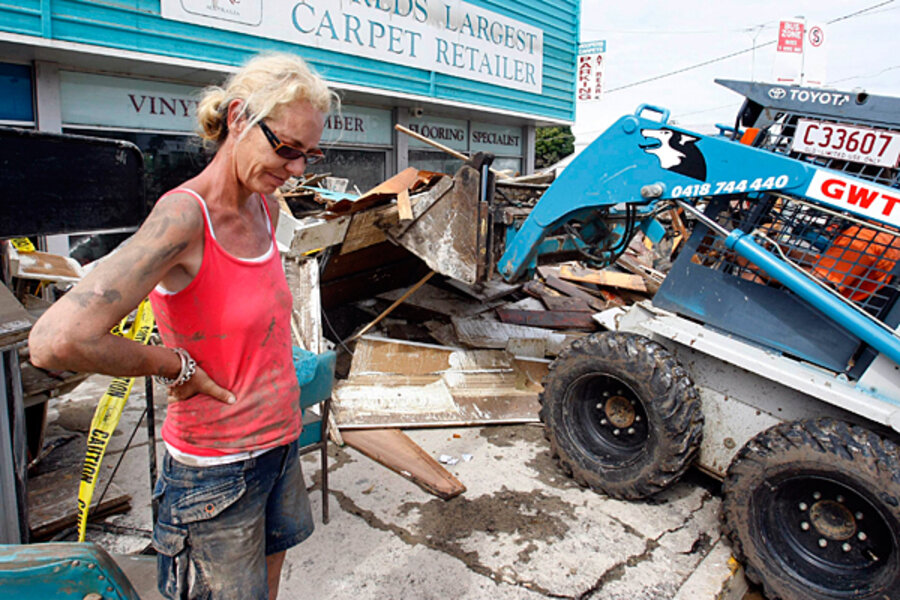After battling Australia floods, waterlogged citizens now fight insurers
Loading...
| Melbourne, Australia
When is a flood not a flood? For Australians tackling a clean-up of “post-war proportions” from more than two months of devastating floods, it depends on your insurance policy.
After battling floodwaters that inundated Australia’s eastern coast – swallowing towns, damaging properties and infrastructure, wiping out crops and livestock, and killing 32 people in the state of Queensland – some here are now finding themselves in a fight over insurance coverage.
A number of residents in Queensland’s riverside capital Brisbane, who watched helplessly as the Brisbane River burst its banks and engulfed their homes, are seeking legal advice after being told the flood clause in their insurance policy only covered stormwater damage, not “river inundation.”
So who foots the bill for the flood damage? Prime Minister Julia Gillard is eying the wealthy, on Thursday introducing a one-time tax on the middle- and upper-class to help cover what she said would be a $5.6 billion damage bill. Now, as Australians roll up their sleeves and begin putting their homes and businesses back in order, a fight is brewing between tax payers, flood victims, the government, and insurance companies.
Not all water is equal
This is just the beginning. As all that insurance policy fine print finally sees the light of day, many flood victims are finding that not all waters are treated equally. Some policies only cover damage from water that has overflowed from “natural watercourses.” Property owners waist-deep in water that spilled over from reservoirs, dams, canals, or other manmade waterways need not apply.
And then there is the question of what flood damage is. Owners of properties damaged from earth being piled up against them during flooding may be left high and dry by their insurer.
“We are still in the early days regarding claims,” says Catherine Uhr, a consumer protection lawyer with Legal Aid Queensland, which is providing advice to unhappy policy holders. “The barrage of complaints is still really yet to come as people work through their policies.”
As radio switchboards light up with callers and newspapers ask flood victims to send in details about their experiences with insurance companies, the government is stepping into the fray. Assistant Treasurer Bill Shorten will meet with insurance executives on Tuesday to review an industry that he says needs an overhaul.
“I don’t want to bash insurance companies, but there is real and justified frustration,” Mr. Shorten said on Wednesday. “Why do we need so much fine print? The Magna Carta, the Ten Commandments, and the United States Declaration of Independence were all less than 300 words.”
This is not entirely accurate. Magna Carta has nearly 5,000 words, the Ten Commandments number more than 310 words, and the US Declaration of Independence has about 1,300 words, not including 56 signatures. But Shorten's message appeared clear:
"It should be a tick-and-flick plain English contract where you know you are covered for fire, storm damage, flood and so on," he added.
Should government fill the void?
The government is being backed by consumer advocacy groups, which are calling for a national inquiry into flood insurance. Coming up with a standard definition of just what constitutes a flood and promoting better policy disclosure before consumers sign the dotted line are their key demands.
“Disclosure is a problem,” says Christopher Zinn, media spokesperson for the consumer advocacy group Choice. “Insurance companies are very keen to tell you what is in their policies, but people are really interested in what is left out. There needs to be mandatory one-page fact sheets provided with policies which contain a simple and clear list of policy exclusions.”
Mr. Zinn says the government should consider setting up a national fund to cover natural disasters, similar to how New Zealand covers earthquake damage. Queensland-based members of the ruling Labor party have gone so far as to threaten the insurance industry with a rival public insurance plan should the upcoming talks fail to bear fruit.
Australia’s insurance industry concedes reform is needed. Robert Whelan, chief executive officer of the Insurance Council of Australia, said Thursday that it is time to settle upon a “common definition of a flood,” but he added that insurers should “retain the right to derogate and amend the definition” to take into account “unusual terms.”
The council, which represents many of the country's biggest insurers, lays much of the blame on consumers, saying they should have read their insurance policies more closely. It has also attacked the government’s flood tax, along with proposals to introduce a national disaster fund.
“The flood levy may have unintended consequences – creating a moral hazard and encouraging fewer people to take responsibility for their own risks through purchasing appropriate insurance products,” Mr. Whelan told reporters.
(Editor's Note: The original version of this story misidentified the location of Queensland.)





